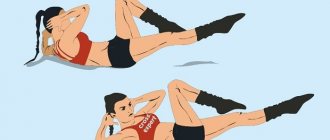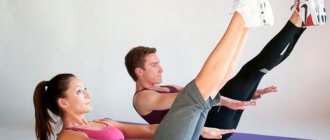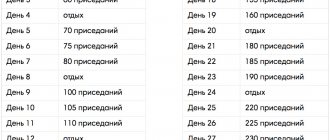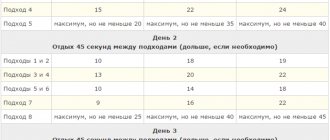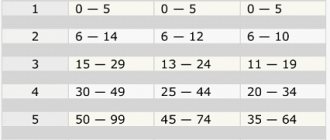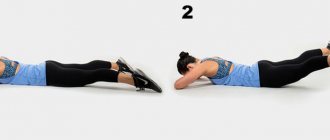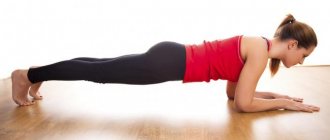Negative repetitions on the horizontal bar
What it is? These are lowering from the top point of the horizontal bar on your hands down. To perform the exercise, you need to place a stand near the horizontal bar or find a low horizontal bar. Jump onto the horizontal bar as if you had already pulled yourself up, and try to slowly lower yourself down.
In the first workout you need to do 4 sets of 5 repetitions. It is recommended to go down as slowly as possible. There is no need to try to do more work if there have been no exercises before, the indicated load for the muscles will be enough. In order for them to grow, they need rest.
It is worth sticking to the parameters in the table, in such cases the training will be effective.
| Training day | Approaches | Number of repetitions | |||||
| Approach 1 | Approach 2 | Approach 3 | Approach 4 | Approach 5 | Approach 6 | ||
| Workout 1 | 4 | 5 | 5 | 5 | 5 | ||
| Workout 2 | 5 | 6 | 5 | 5 | 5 | 5 | |
| Workout 3 | 5 | 6 | 6 | 6 | 5 | 5 | |
| Workout 4 | 5 | 6 | 6 | 6 | 6 | 6 | |
| Workout 5 | 5 | 7 | 7 | 7 | 6 | 6 | |
| Workout 6 | 5 | 7 | 7 | 7 | 7 | 7 | |
| Workout 7 | 5 | 8 | 8 | 7 | 7 | 7 | |
| Workout 8 | 5 | 8 | 8 | 8 | 8 | 7 | |
| Workout 9 | 6 | 8 | 8 | 8 | 8 | 6 | 6 |
| Workout 10 | 6 | 9 | 9 | 8 | 8 | 8 | 7 |
| Workout 11 | 6 | 9 | 9 | 9 | 9 | 8 | 7 |
| Workout 12 | 6 | 9 | 9 | 9 | 9 | 9 | 8 |
| Workout 13 | 6 | 10 | 10 | 9 | 9 | 9 | 9 |
| Workout 14 | 6 | 10 | 10 | 10 | 10 | 9 | 9 |
| Workout 15 | 6 | 10 | 10 | 10 | 10 | 10 | 10 |
After several workouts, you need to lower yourself as slowly as possible to get maximum effect.
An alternative to traditional cardio exercises
Then I remembered how one of the two Russian stuntmen working in Hollywood told me about the strange reaction of the body to pull-ups. It’s as if the brain is giving a command: “Come on, everyone who is responsible for burning fat, remove excess weight!” It’s hard for me to lift this carcass to the crossbar!” Really, have you ever seen a fat rock climber
?
In general, this idea seemed logical to me, and I began to diligently do pull-ups every day. Maybe not 1000 times, as my friend, who later became an Olympic medalist, did, but quite a lot. Once I even argued with a stuntman
, a gymnast in the past, who could do the most pull-ups, and defeated him. The gymnast did 36 pull-ups and, pleased with himself, looked at me with the look of a winner. I made 46. But I didn’t look anywhere - my hands literally went away for another 10 minutes after the victory. Be that as it may, I achieved the main thing - my weight was consistently kept 5 kg lower than before the injury!
Upper block pull
This is an auxiliary exercise; the method of work is similar to a pull-up on a bar. During the first, second and third workouts, you need to use a light weight for free work, while following the technique, do 5 sets of 15 repetitions.
It is worth paying attention
If during the first approach the exercise was performed without much effort, then you can add weight in the next approach. If it is difficult, then it is recommended to reduce the weight.
In subsequent workouts , when the athlete understands which muscles are involved in the exercise, then it is worth doing 5 sets of 8 repetitions. At the same time, additional weight should be added only if there are no difficulties in the approach and it is easy. But in no case should you forget to follow the technique.
Before starting your workout, you should try doing pull-ups on the horizontal bar, maybe today is your day and you’ll be able to do some pull-ups. With this method of training, you can learn to feel your back, and at the same time pump up the muscles that are involved in working on the bar.
Technique for performing overhead rows with a wide grip:
- Set up the machine, put on a light weight;
- Grasp the handle with your hands, choose a comfortable wide grip;
- Without letting go of the handle, sit down at the exercise machine;
- Using the force of your hands, pull it down to the middle;
- After this, when the back muscles are involved in the work, you need to pull the bar up to the chin, bringing your shoulder blades together;
- Slowly return to the starting position.
Once again about the filming process...
One day, a famous director asked me to do all the stunts myself
in an action film we were working on at the time.
He motivated this by the fact that not a single stuntman can repeat the “physics” of the champion. Veiled flattery and praise did their job - I began to do everything myself. When it came to fights, I didn’t let my stunt doubles get close anyway, but with jumping, falling and auto stunts, everything turned out to be more complicated and dangerous. And so, having overloaded my legs during the day
, during an elementary jump I tear the ligaments on my right knee. I quickly had surgery, and a specialist fitted me with a hard knee brace, so I was back in action in a couple of weeks. It is clear that now it was only possible to play in front of the camera “from the waist up.” A week later, I suddenly began to notice that I was starting to increase in size. I had to urgently find an alternative to running and cycling - with the help of this kind of cardio exercise before the break, I managed to keep myself in shape, but now it was impossible to overload my legs.
Partner Help
It's worth asking someone to help you pull yourself up. The partner's job is to help you pull up slightly.
How it's done? The trainee jumps onto the horizontal bar, and a partner takes him by the waist or leg and helps him reach the top point. After that, try to go down to the bottom on your own. And at the bottom point, your partner must again help you pull yourself up.
How many times should I do this? It is worth relying on the data indicated in the table in “negative repetitions on the horizontal bar”. The main thing here is to look for a middle ground so that the partner does not take on a lot of weight, and it is easy for the athlete to pull himself up. At the same time, he should help so much that the number of approaches and repetitions that is planned is completed.
With elastic band
The principle of operation is similar to the previous paragraph. The athlete places the elastic band on the horizontal bar, inserts his leg into it, and pulls himself up, additionally helping himself with his leg. This option is more effective than with a partner. Firstly, there is no need to look for a partner, and secondly, the athlete himself recognizes how much additional help he needs in pulling up.
Pull-up technique
- Choose a grip for pull-ups (wide grip, narrow grip, reverse grip);
- Choose a method of assistance in pulling up (negative pull-ups, help from a partner, with an elastic band);
- Grasp the crossbar with your hands;
- Using the strength of your arms, stretch to the middle, then engage your back muscles. Reach your chin just above the bar;
- Make a delay of 1 second;
- Slowly begin to lower down and return to the starting position.
How to learn to do a lot of pull-ups: what a beginner needs to know
It would seem that what could be difficult about pull-ups? But why then can one person do 10 pull-ups, while another can do none? It turns out that many factors influence the final result. These are common mistakes that beginners make, incorrect execution techniques, and much more.
Common mistakes
Before you start training, you need to exclude:
- excess weight;
- underdevelopment of the muscles of the back and shoulders;
- presence of back pain.
Many beginners ignore these nuances, considering them unimportant. In fact, excess everything puts additional stress on the muscles, not allowing them to work to their full potential. As a result, the execution technique also suffers. Therefore, at the beginning it is worth working with weights, and then starting with pull-ups.
Before the main workout, you should also pump up your muscles. Otherwise, there will be no effect, not only quick, but no effect at all. Back pain can also hinder the achievement of the goal. By the way, the latter can also become a direct contraindication to lifting the body on the crossbar. This fact should also be taken into account.
Important! Many beginners also make the same mistake as incorrect execution technique. As a result, the muscles work out of coordination, and the desired effect is not achieved.
Recommendations and tips
The following tips will help beginners achieve their goal as quickly as possible:
- Monitor your mobility During training, watch your muscles. If they are very tense, especially in the spine and chest, then something is going wrong. Work on your technique. Otherwise, additional stress on the spinal column and shoulder joint can cause serious harm.
- Measure your hanging time Learn to just hang for as long as possible first. This way you will achieve an iron grip and strong shoulders.
- Do not jerk. The upward movement should be smooth, without jerking. Only smoothness will give maximum effect and long-awaited power.
- Set realistic goals for yourself It is difficult to increase endurance and strength in one training session. You need to focus on one thing. In the beginning, the entire focus should be on the first push of the pull-up. Next, you can add exercises that help increase the number of lifts.
- Don't expect instant results Yes, you won't be able to do many pull-ups the first time. You will get calluses and your hands will hurt. But it normal! Perseverance and work will take their toll, the main thing is not to give up what you started.
How to do pull-ups on the horizontal bar correctly for beginners
It is a mistake to believe that pull-ups consist of the following pattern: come, hang, pull up, jump. Yes, for one time, maybe this will be enough. But if your goal is to do as many pull-ups as possible, then read the information below.
Start with a warm-up
For ligaments and muscles to work effectively, they need to be warmed up. This will not only give maximum results, but also prevent injuries.
For this purpose, the following preparatory elements can be used:
| What do you need | What we do |
| Children's horizontal bar or parallel bars | We take the equipment with a straight horizontal grip and pull ourselves up to the point where our chest touches the horizontal bar. Feet on the floor. |
| Likewise | The same thing, but with a maximum delay at the top point. Due to statics, joints and tendons can be developed. |
| Sports bands or partner | We attach the elastic bands to the horizontal bar, rest our feet on them and pull ourselves up. Or we ask our partner to hold his feet. This way we reduce weight. |
| Rubber | Use an elastic band to pull yourself up halfway, forming a right angle at the elbows. We hang like this until we fail. In the future, the elastic band can be removed. |
2 effective techniques for beginners
To help beginners, after warming up, you can practice the following exercises:
- Negative repetitions The essence of the element: to gain a foothold on the horizontal bar as if you had already pulled yourself up. To do this, take a chair, stand on it and begin to hang on your bent arms. Place your chin above the bar. After hanging we slowly lower ourselves down. We perform 5 repetitions and get down from the chair to rest. Next we make 4 passes and, after rest, 3 more.
- Work at half amplitude. You will also need a chair. We jump from it and hang on the horizontal bar with our arms bent at right angles. Next, we complete the pull-up using the strength of our arms.
What exercises will allow you to quickly learn how to do pull-ups?
To master pull-ups faster, you must also perform regular push-ups. Moreover, they can be both direct and reverse. The main goal of such training is to strengthen the muscles of the back and shoulders.
The following elements can also help in mastering the skill at lightning speed:
- we jump onto the horizontal bar immediately into the top position, staying there for literally a second, then as slowly as possible we lower ourselves to the starting position;
- we swing on the crossbar in such a way that when the body moves forward, the back and arms also bend forward, and when moving backward, they bend backward;
- climbing a rope with your hands gripping as high as possible from the body.
Performing all the exercises written above will strengthen your muscles and significantly increase the number of pull-ups.
What muscles are involved?
During training, a beginner is faced with the fact that he does not understand which muscles should be included in the work. During training, the following muscles work:
- The latissimus dorsi is the main muscle that is involved in all exercises that involve pulling up. The larger the muscle, the wider the back will be;
- Teres major muscle - helps the latissimus muscles pull the elbows to the sides of the body and pull the shoulders back;
- The rhomboid muscle is located under the trapezius, its role is to rotate the shoulder blades downward;
- Biceps – biceps brachii muscle;
- The brachialis is a small shoulder muscle that comes into play with a standard grip. With a reverse grip, it is not included in the work; because of this, it is easier to learn to do pull-ups with a reverse grip.
How often should you exercise to improve results?
After training, the body must recover, so you should not train every day. Rest can be taken from 1 to 7 days. You should not take a long rest, this may discourage you from training.
It is recommended to exercise every 2 days. For example, if the lesson was on Monday, then on Tuesday is a rest day, on Wednesday do another training session, on Friday work out again, and on Saturday and Sunday have a rest. This way, training will take place on the same days. Additionally, you can do a heavy load on Monday and Friday, and do a light workout on Wednesday.
Several factors that hinder beginners
You can often hear that training does not bring the desired results to beginners, although the exercise technique is fully followed. In such cases, it makes sense to pay attention to the most common reasons why beginners cannot achieve the desired result:
- Overweight. Excess weight increases the load on the muscles when doing pull-ups. In such cases, it is worth switching to proper nutrition and increasing your calorie consumption per day.
- Physical weakness. If the weight does not exceed the permissible norms, but it is difficult to pull yourself up, then the problem is that the muscles are not developed enough. They should be further developed through physical activity.
- Unproven technology. If you improve your technique, you can achieve better results. What is technology? This is the correct execution of exercises while observing the established rules. With the correct technique, the maximum amount of muscle will be involved, because of this they will develop faster. As a result, the athlete will be able to do more repetitions.
About the benefits of pull-ups
If you remember, each of us tried to do regular or lightweight pull-ups in physical education classes at school. The rope has also always been an integral part of the interior of any gym, and everyone has many funny stories associated with it. Pull-ups and rope
are basic and indispensable exercises for developing the back, shoulders, arms, and pectoral muscles.
Thanks to them, a beautiful and athletic male figure is formed, and a female figure becomes slim and fit. Pull-ups are a fairly energy-intensive exercise
and require a lot of effort at first. Therefore, there is little else that will so clearly and quickly indicate to you that you are overweight and the general condition of your upper muscle corset. Not normal - and thoughts about the crossbar remain dreams. But you still need to pull yourself up!
Contraindications for pull-ups
There are several reasons why doctors do not recommend doing pull-ups. You should not exercise on the horizontal bar with the following diseases:
- scoliosis (curvature of the spine);
- spinal protrusion;
- herniated intervertebral discs.
People with osteochondrosis should exercise with caution on the bar. Such exercises will help improve blood circulation and develop mobility of vertebral structures. But excessive load with degenerative changes in the vertebrae is contraindicated. If you have any other back problems, it is recommended to exercise with caution, and do not forget to consult a doctor.
The athlete independently determines which method to choose for learning pull-ups. In such cases, individual preferences are taken into account; whichever method turns out to be easier and more accessible, use it. You can also experiment: do one workout one way, and the next another.
You should practice wisely, follow the technique, do not overload yourself, and then everything will work out.
